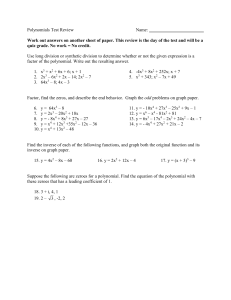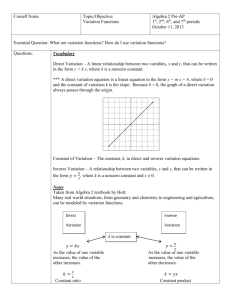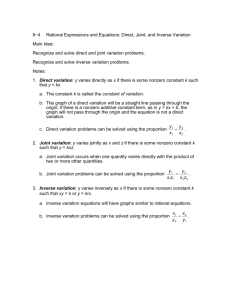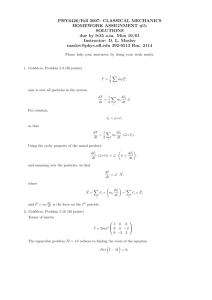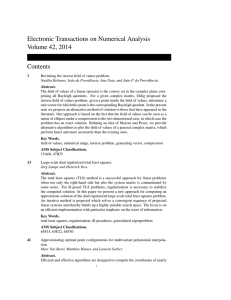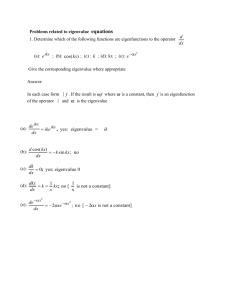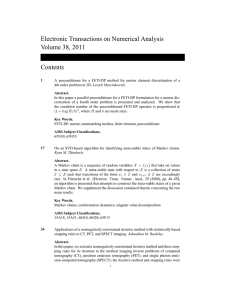THE ADDITIVE INVERSE EIGENVALUE PROBLEM AND
advertisement
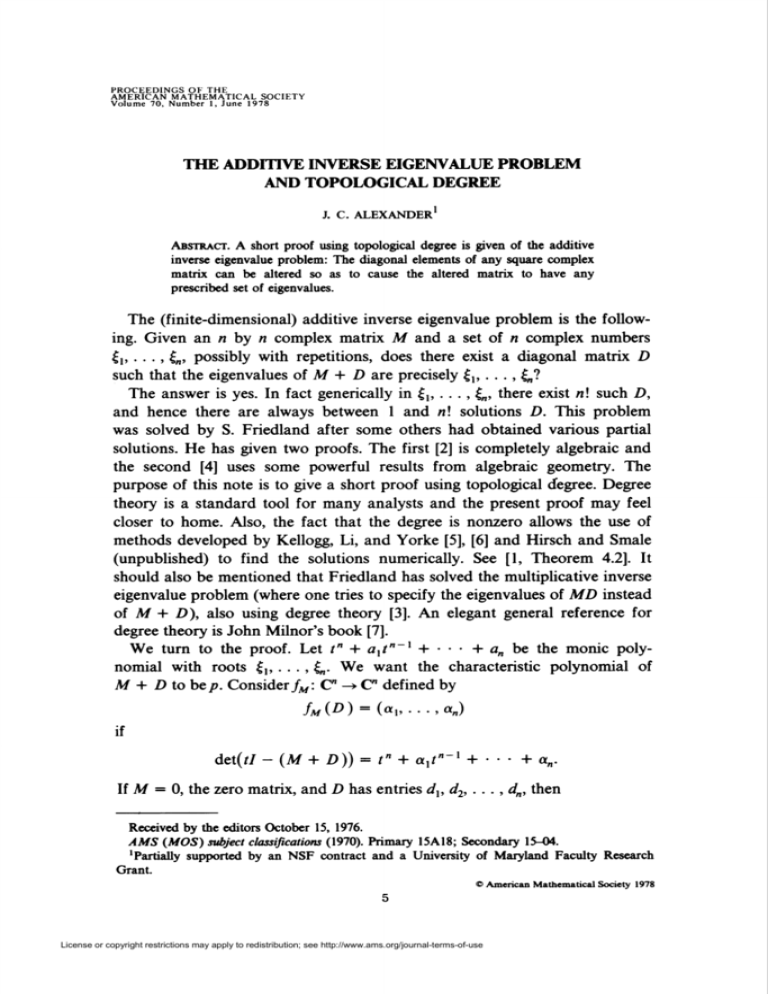
PROCEEDINGS OF THE
AMERICAN MATHEMATICAL SOCIETY
Volume 70, Number 1, June 1978
THE ADDITIVEINVERSEEIGENVALUEPROBLEM
AND TOPOLOGICALDEGREE
J. C. ALEXANDER1
Abstract. A short proof using topological degree is given of the additive
inverse eigenvalue problem: The diagonal elements of any square complex
matrix can be altered so as to cause the altered matrix to have any
prescribed set of eigenvalues.
The (finite-dimensional) additive inverse eigenvalue problem is the following. Given an n by n complex matrix M and a set of n complex numbers
£,, .. ., £„, possibly with repetitions, does there exist a diagonal matrix D
such that the eigenvalues of M + D are precisely £,, . . . , £„?
The answer is yes. In fact generically in £„ . . . , £„, there exist n\ such D,
and hence there are always between 1 and n\ solutions D. This problem
was solved by S. Friedland after some others had obtained various partial
solutions. He has given two proofs. The first [2] is completely algebraic and
the second [4] uses some powerful results from algebraic geometry. The
purpose of this note is to give a short proof using topological degree. Degree
theory is a standard tool for many analysts and the present proof may feel
closer to home. Also, the fact that the degree is nonzero allows the use of
methods developed by Kellogg, Li, and Yorke [5], [6] and Hirsch and Smale
(unpublished) to find the solutions numerically. See [1, Theorem 4.2]. It
should also be mentioned that Friedland has solved the multiplicative inverse
eigenvalue problem (where one tries to specify the eigenvalues of MD instead
of M + D), also using degree theory [3]. An elegant general reference for
degree theory is John Milnor's book [7].
We turn to the proof. Let t" + axt"~x + • ■ ■ + an be the monic polynomial with roots I,, . . . , £„. We want the characteristic polynomial of
M + D to be p. Consider fM: C -* C defined by
fMiD)
= iax,...,an)
if
det(i/ - (A/ + D)) = t" + axt"-x + • ■ ■ + an.
If M = 0, the zero matrix, and D has entries dx,d2, . .., d„, then
Received by the editors October 15, 1976.
AMS (A/OS) subject classifications(1970). Primary 15A18; Secondary 15-04.
'Partially supported by an NSF contract and a University of Maryland Faculty Research
Grant.
© American Mathematical
5
License or copyright restrictions may apply to redistribution; see http://www.ams.org/journal-terms-of-use
Society 1978
J. C. ALEXANDER
6
fM(D) = (t-dx)(t-d2)---(t-dn).
It can be checked that eachfM is proper, that all/M are properly homotopic to
/0 and that/0 has degree n\. Th\xsfM also has degree n\. These details can be
checked, but we have chosen to proceed slightly differently by compactifying
the problem and using degree defined for closed compact manifolds rather
than work with proper maps.
Let complex projective space
C7>"={[«0,...,a„]|a,.
EC, 2|«,|2^0},
where [a0, . . ., an] = [Aa0, . . ., Aa„] for any nonzero X G C. We identify
CP" with the space of all nonzero complex polynomials a0t" + axt"~x
+ • • • + a„ modulo scalar multiples. In particular we consider/? E CP". Let
D have entries dx, . . . , dn. One-point compactify each copy of C to a
Riemann sphere and consider d¡ E C U {00} = S2. We claim the map fiM
extends to a map
f„: S2 X ■ ■ ■ X S2->CP".
n times
To see that/M extends, let M = (m^), and suppose dx is large. Then
_L_ Uhl_ !
ühi
m2x
t — m22 — d2
• • •
mn\
mnl
* * '
dx
/„(/>)
= det
dx
Obi
dx
dx
m2n
' -
mnn~
dn
ECP".
Thus if dx (or more generally if any subset of the ¿/'s) goes to infinity, the
value oifM(D) approaches a limit in CP". Note that/M is complex analytic in
both M and D. Note also that if k of the d¡ are equal to infinity, then the
degree of the polynomial fM(D) is n — k. In particular, d¡ i= 00 for all / if
degreef„ (D) = n.
If M = 0, the topological degree of fM is well known to be w!. (Two sketch
proofs: (i) Treating S2 = QPX as nonzero linear polynomials, f0: (S2)" —>
CP" is multiplication of polynomials. For all factors fixed at 0 • t + 1 except
for one, say S,2, the map /0 is the inclusion of S2 = CP ' in CP". Hence the
generator of H2(CP") maps to the generator of H2(S2). Using the cup
product structures of H*(CP") and 77*((S2)"), we see H2"(CP")^
H2"((S2)") is multiplication by «!. (ii) Again treating /„: (S2)"^CP"
as
multiplication of polynomials, it can be checked that a polynomial q(t) E
CP" is a regular value of p0 if and only if all its roots (/-,,...,
rn) are distinct.
The preimage of q(t) is the n\ products
w - (r - r.) ...(/-
n),
License or copyright restrictions may apply to redistribution; see http://www.ams.org/journal-terms-of-use
ADDITIVE INVERSE EIGENVALUE PROBLEM
7
where (/,,...,
/„) is a permutation of (1, . . ., n). The local degree at each it
is 1, so the global degree is n\.) The map/M is homotopic to/0, so the degree
of fM is also n\. In particular, fM is surjective and so there exists D such that
Im(D) = p.
Moreover, by Sard's Theorem a generic set of q E CP" are regular values
of fM. The local degree of fM at each point in the inverse image of a regular q
is +1 since fM is complex analytic. Therefore fñ xiq) has n\ points if q is
regular. This completes the proof.
References
1. S.-N. Chow, J. Mallet-Paret and J. A. Yorke, Finding zeroes of maps: homotopy methods that
are constructive with probability one (preprint).
2. S. Friedland, Matrices with prescribed off-diagonal elements, Israel J. Math. 11 (1972),
184-189.
3._,
On inverse multiplicative eigenvalue problems for matrices, Linear Algebra and Appl.
12 (1975),127-137.
4._,
Inverse eigenvalue problems (preprint).
5. R. B. Kellogg, T. Y. Li and J. A. Yorke, A method of continuation for calculating a Brouwer
fixed point, Fixed Points, Algorithms and Applications, S. Karamadian (editor), Academic Press,
New York, 1977.
6. _,
A constructive proof of the Brouwer Fixed Point Theorem and computational results,
SIAM J. Numer. Anal. 13 (1976),473-483.
7. J. W. Milnor, Topology from the differential viewpoint, Univ. of Virginia Press, Charlottes-
ville, Va., 1965.
Department of Mathematics, University of Maryland, College Park, Maryland
Current address (until September 1978): Mathematisches
Bonn 1, Federal Republic of Germany
20742
Institut der Universität Bonn, 5300
License or copyright restrictions may apply to redistribution; see http://www.ams.org/journal-terms-of-use
